Spatiotemporal Dynamics of Forest Fire Risk in Southeastern China Under Climate Change: Hydrothermal Drivers and Future Projections
Abstract
1. Introduction
2. Materials and Methods
2.1. Study Area
2.2. Data Source
2.3. Risk Assessment
2.4. Statistical Analysis
3. Results
3.1. Characteristics of Forest Fires
3.2. Evaluation of Machine Learning Methods
3.3. Changes in Hydrothermal Conditions
3.4. Projection of Forest Fire Potential
4. Discussion
5. Conclusions
Author Contributions
Funding
Institutional Review Board Statement
Informed Consent Statement
Data Availability Statement
Conflicts of Interest
References
- Abatzoglou, J.T.; Kolden, C.A.; Cullen, A.C.; Sadegh, M.; Williams, E.L.; Turco, M.; Jones, M.W. Climate Change Has Increased the Odds of Extreme Regional Forest Fire Years Globally. Nat. Commun. 2025, 16, 6390. [Google Scholar] [CrossRef]
- Zheng, B.; Ciais, P.; Chevallier, F.; Chuvieco, E.; Chen, Y.; Yang, H. Increasing Forest Fire Emissions Despite the Decline in Global Burned Area. Sci. Adv. 2021, 7, eabh2646. [Google Scholar] [CrossRef]
- Shivaprasad, K.M.; Sowmya, M.S.; Danakumara, T.; Gowda, M.M.; Kumar, R.; Kumar, S.D.; Kumar, B.S. Chapter 4-Forest Fire and Its Impact on Forest Biodiversity. In Forests for Inclusive and Sustainable Economic Growth; Saikia, P., Kumar, A., Khan, M.L., Lei, X., Eds.; Elsevier: Amsterdam, The Netherlands, 2025; pp. 37–53. [Google Scholar] [CrossRef]
- Wunder, S.; Calkin, D.E.; Charlton, V.; Feder, S.; Martínez de Arano, I.; Moore, P.; Rodríguez y Silva, F.; Tacconi, L.; Vega-García, C. Resilient Landscapes to Prevent Catastrophic Forest Fires: Socioeconomic Insights Towards a New Paradigm. For. Policy Econ. 2021, 128, 102458. [Google Scholar] [CrossRef]
- Brown, P.T.; Hanley, H.; Mahesh, A.; Reed, C.; Strenfel, S.J.; Davis, S.J.; Kochanski, A.K.; Clements, C.B. Climate Warming Increases Extreme Daily Wildfire Growth Risk in California. Nature 2023, 621, 760–766. [Google Scholar] [CrossRef]
- Jones, M.W.; Abatzoglou, J.T.; Veraverbeke, S.; Andela, N.; Lasslop, G.; Forkel, M.; Smith, A.J.P.; Burton, C.; Betts, R.A.; van der Werf, G.R.; et al. Global and Regional Trends and Drivers of Fire Under Climate Change. Rev. Geophys. 2022, 60, e2020RG000726. [Google Scholar] [CrossRef]
- Abatzoglou, J.T.; Williams, A.P. Impact of Anthropogenic Climate Change on Wildfire Across Western US Forests. Proc. Natl. Acad. Sci. USA 2016, 113, 11770–11775. [Google Scholar] [CrossRef]
- Gong, D.; Sun, L.; Hu, T. Characterizing the Occurrence of Wildland-Urban Interface Fires and Their Important Factors in China. Ecol. Indic. 2024, 165, 112179. [Google Scholar] [CrossRef]
- Tian, X.; Zhao, F.; Shu, L.; Wang, M. Forest Fire Risk Assessment for China Under Different Climate Scenarios. Chin. J. Appl. Ecol. 2016, 27, 769–776. [Google Scholar] [CrossRef]
- Tian, X.R.; Shu, L.F.; Zhao, F.J.; Wang, M.Y. Impacts of Climate Change on Forest Fire Danger in China. Sci. Ailvae Sin. 2017, 53, 159–169. [Google Scholar] [CrossRef]
- Fazel-Rastgar, F.; Sivakumar, V. Weather Pattern Associated with Climate Change During Canadian Arctic Wildfires: A Case Study in July 2019. Remote Sens. Appl. Soc. Environ. 2022, 25, 100698. [Google Scholar] [CrossRef]
- Kang, Y.; Jang, E.; Im, J.; Kwon, C.; Kim, S. Developing a New Hourly Forest Fire Risk Index Based on Catboost in South Korea. Appl. Sci. 2020, 10, 8213. [Google Scholar] [CrossRef]
- Lan, Z.; Su, Z.; Guo, M.; Alvarado, E.; Guo, F.-T.; Hu, H.; Wang, G.; Oliveira, S. Are Climate Factors Driving the Contemporary Wildfire Occurrence in China? Forests 2021, 12, 392. [Google Scholar] [CrossRef]
- Zhao, F.-J.; Liu, Y. Atmospheric Circulation Patterns Associated with Wildfires in the Monsoon Regions of China. Geophys. Res. Lett. 2019, 46, 4873–4882. [Google Scholar] [CrossRef]
- Ellis, T.M.; Bowman, D.; Jain, P.; Flannigan, M.D.; Williamson, G.J. Global Increase in Wildfire Risk Due to Climate-Driven Declines in Fuel Moisture. Glob. Change Biol. 2022, 28, 1544–1559. [Google Scholar] [CrossRef]
- Vilar, L.; Herrera, S.; Tafur-García, E.; Yebra, M.; Martinez-Vega, J.; Echavarría, P.; Martín, M.P. Modelling Wildfire Occurrence at Regional Scale from Land Use/Cover and Climate Change Scenarios. Environ. Model. Softw. 2021, 145, 105200. [Google Scholar] [CrossRef]
- Shmuel, A.; Lazebnik, T.; Heifetz, E.; Glickman, O.; Price, C. Fire Weather Indices Tailored to Regional Patterns Outperform Global Models. npj Nat. Hazards 2025, 2, 74. [Google Scholar] [CrossRef]
- Tian, X.; Zhao, F.J.; Shu, L.F.; Wang, M.Y. Changes in Forest Fire Danger for South-Western China in the 21st Century. Int. J. Wildland Fire 2014, 23, 185–195. [Google Scholar] [CrossRef]
- Tian, X.; McRae, D.J.; Shu, L.; Zhao, F.; Wang, M. Changes of Forest Fire Danger and the Evaluation of the FWI System Application in the Daxing’anling Region. Sci. Silvae Sin. 2010, 46, 127–132. [Google Scholar] [CrossRef]
- Yang, M.; Yao, Q.; Fang, K.; Dong, Z. Applications of Canadian Forest Fire Weather Index System in the World and China. J. Subtrop. Resour. Environ. 2021, 16, 48–54. [Google Scholar] [CrossRef]
- Van Wagner, C.E. Development and Structure of the Canadian Forest Fire Weather Index System; Forestry Technical Report; Canadian Forestry Service: Ottawa, ON, Canada, 1987; 35p. [Google Scholar]
- Stocks, B.J.; Lynham, T.J.; Lawson, B.D.; Alexander, M.E.; Van Wagner, C.E.; McAlpine, R.S.; Dubé, D.E. Canadian Forest Fire Danger Rating System: An Overview. For. Chron. 1989, 65, 258–265. [Google Scholar] [CrossRef]
- Chelli, S.; Maponi, P.; Campetella, G.; Monteverde, P.; Foglia, M.; Paris, E.; Lolis, A.; Panagopoulos, T. Adaptation of the Canadian Fire Weather Index to Mediterranean forests. Nat. Hazards 2015, 75, 1795–1810. [Google Scholar] [CrossRef]
- Tian, X.; Zhao, F.; Shu, L.; Wang, M. Distribution Characteristics and the Influence Factors of Forest Fires in China. For. Ecol. Manag. 2013, 310, 460–467. [Google Scholar] [CrossRef]
- Zong, X.; Tian, X.; Liu, J. A Fire Regime Zoning System for China. Front. For. Glob. Chang. 2021, 4, 717499. [Google Scholar] [CrossRef]
- Tsinko, Y.; Bakhshaii, A.; Johnson, E.A.; Martin, Y.E. Comparisons of Fire Weather Indices Using Canadian Raw and Homogenized Weather Data. Agric. For. Meteorol. 2018, 262, 110–119. [Google Scholar] [CrossRef]
- Li, D.; Feng, J.; Dosio, A.; Qi, J.; Xu, Z.; Yin, B. Historical Evaluation and Future Projections of 100-m Wind Energy Potentials Over CORDEX-East Asia. J. Geophys. Res. Atmos. 2020, 125, e2020JD032874. [Google Scholar] [CrossRef]
- Sillmann, J.; Kharin, V.V.; Zhang, X.; Zwiers, F.W.; Bronaugh, D. Climate Extremes Indices in the CMIP5 Multimodel Ensemble: Part 1. Model Evaluation in the Present Climate. J. Geophys. Res. Atmos. 2013, 118, 1716–1733. [Google Scholar] [CrossRef]
- Su, B.; Huang, J.; Mondal, S.K.; Zhai, J.; Wang, Y.; Wen, S.; Gao, M.; Lv, Y.; Jiang, S.; Jiang, T.; et al. Insight from CMIP6 SSP-RCP Scenarios for Future Drought Characteristics in China. Atmos. Res. 2021, 250, 105375. [Google Scholar] [CrossRef]
- You, Q.; Cai, Z.; Wu, F.; Jiang, Z.; Pepin, N.; Shen, S.S.P. Temperature Dataset of CMIP6 Models Over China: Evaluation, Trend and Uncertainty. Clim. Dyn. 2021, 57, 17–35. [Google Scholar] [CrossRef]
- Kondylatos, S.; Prapas, I.; Ronco, M.; Papoutsis, I.; Camps-Valls, G.; Piles, M.; Fernandez-Torres, M.A.; Carvalhais, N. Wildfire Danger Prediction and Understanding with Deep Learning. Geophys. Res. Lett. 2022, 49, e2022GL099368. [Google Scholar] [CrossRef]
- Thompson, M.P.; Zimmerman, T.; Mindar, D.; Taber, M. Risk Terminology Primer: Basic Principles and a Glossary for the Wildland Fire Management Community; U.S. Department of Agriculture, Forest Service, Rocky Mountain Research Station: Fort Collins, CO, USA, 2016. Available online: https://www.govinfo.gov/content/pkg/GOVPUB-A13-PURL-gpo71455/pdf/GOVPUB-A13-PURL-gpo71455.pdf (accessed on 25 August 2025).
- Pettinari, M.L.; Chuvieco, E. Fire Danger Observed from Space. Surv. Geophys. 2020, 41, 1437–1459. [Google Scholar] [CrossRef]
- Chen, R.; He, B.; Li, Y.; Fan, C.; Yin, J.; Zhang, H.; Zhang, Y. Estimation of Potential Wildfire Behavior Characteristics to Assess Wildfire Danger in Southwest China Using Deep Learning Schemes. J. Environ. Manag. 2024, 351, 120005. [Google Scholar] [CrossRef] [PubMed]
- Koutsias, N.; Balatsos, P.; Kalabokidis, K. Fire Occurrence Zones: Kernel Density Estimation of Historical Wildfire Ignitions at the National Level, Greece. J. Maps 2014, 10, 630–639. [Google Scholar] [CrossRef]
- Fu, J.; Niu, J.; Sivakumar, B. Prediction of Vegetation Anomalies Over an Inland River Basin in North-Western China. Hydrol. Process. 2018, 32, 1814–1827. [Google Scholar] [CrossRef]
- Han, D.; Liu, S.; Du, Y.; Xie, X.; Fan, L.; Lei, L.; Li, Z.; Yang, H.; Yang, G. Crop Water Content of Winter Wheat Revealed with Sentinel-1 and Sentinel-2 Imagery. Sensors 2019, 19, 4013. [Google Scholar] [CrossRef]
- Wu, L.; Zhou, H.; Ma, X.; Fan, J.; Zhang, F. Daily Reference Evapotranspiration Prediction Based on Hybridized Extreme Learning Machine Model with Bio-Inspired Optimization Algorithms: Application in Contrasting Climates of China. J. Hydrol. 2019, 577, 123960. [Google Scholar] [CrossRef]
- Scholze, M.; Knorr, W.; Arnell, N.W.; Prentice, I.C. A Climate-Change Risk Analysis for World Ecosystems. Proc. Natl. Acad. Sci. USA 2006, 103, 13116–13120. [Google Scholar] [CrossRef]
- Shi, X.; Zhao, D.; Wu, S.; Shi, W.; Dai, E.; Wang, W. Climate Change Risks for Net Primary Production of Ecosystems in China. Human Ecol. Risk Assess. Int. J. 2016, 22, 1091–1105. [Google Scholar] [CrossRef]
- Duman, Z.; Mao, X.; Cai, B.; Zhang, Q.; Chen, Y.; Gao, Y.; Guo, Z. Exploring the Spatiotemporal Pattern Evolution of Carbon Emissions and Air Pollution in Chinese Cities. J. Environ. Manag. 2023, 345, 118870. [Google Scholar] [CrossRef] [PubMed]
- Han, H.J. Interpretation of the old and new “Forest Fire Prevention Regulations”. Leg. Syst. Soc. 2009, 12, 331–332. [Google Scholar] [CrossRef]
- Zhou, Q.; Zhang, H.; Wu, Z. Effects of Forest Fire Prevention Policies on Probability and Drivers of Forest Fires in the Boreal Forests of China during Different Periods. Remote Sens. 2022, 14, 5724. [Google Scholar] [CrossRef]
- Zhai, J.; Wang, L.; Liu, Y.; Wang, C.; Mao, X. Assessing the effects of China’s three-north shelter forest program over 40 years. Sci. Total Environ. 2023, 857, 159354. [Google Scholar] [CrossRef]
- Qiao, D.; Yuan, W.T.; Ke, S.F. China’s Natural Forest Protection Program: Evolution, impact and challenges. Int. For. Rev. 2021, 23, 338–350. [Google Scholar] [CrossRef]
- Yin, R. Evaluating the socioeconomic and ecological impacts of China’s forest policies, program, and practices: Summary and outlook. For. Policy Econ. 2021, 127, 102439. [Google Scholar] [CrossRef]
- Hu, T.; Xu, Z.; Yu, C.; Dou, X.; Zhang, Y.; Sun, L. Impacts of different forest fire management policies and fuel treatment models on forest fire risk in boreal forest of China. Ecol. Indic. 2024, 169, 112806. [Google Scholar] [CrossRef]
- Hayes, J.P. Fire Suppression and the Wildfire Paradox in Contemporary China: Policies, Resilience, and Effects in Chinese Fire Regimes. Hum. Ecol. 2021, 49, 19–32. [Google Scholar] [CrossRef]
- Covington, W.W.; Everett, R.L.; Steele, R.; Irwin, L.L.; Daer, T.A.; Auclair, A.N.D. Historical and Anticipated Changes in Forest Ecosystems of the Inland West of the United States. J. Sustain. For. 1994, 2, 13–63. [Google Scholar] [CrossRef]
- Richardson, D.; Black, A.S.; Irving, D.; Matear, R.J.; Monselesan, D.P.; Risbey, J.S.; Squire, D.T.; Tozer, C.R. Global Increase in Wildfire Potential from Compound Fire Weather and Drought. npj Clim. Atmos. Sci. 2022, 5, 23. [Google Scholar] [CrossRef]
- Yang, X.; Zhou, B.; Xu, Y.; Han, Z. CMIP6 Evaluation and Projection of Temperature and Precipitation over China. Adv. Atmos. Sci. 2021, 38, 817–830. [Google Scholar] [CrossRef]
- Rigden, A.J.; Salvucci, G.D. Stomatal Response to Humidity and CO2 Implicated in Recent Decline in US Evaporation. Glob. Change Biol. 2017, 23, 1140–1151. [Google Scholar] [CrossRef]
- Hu, Y.; Wei, F.; Wang, S.; Zhang, W.; Fensholt, R.; Xiao, X.; Fu, B. Critical Thresholds for Nonlinear Responses of Ecosystem Water Use Efficiency to Drought. Sci. Total Environ. 2024, 918, 170713. [Google Scholar] [CrossRef]
- Pivovaroff, A.L.; Emery, N.; Sharifi, M.R.; Witter, M.; Keeley, J.E.; Rundel, P.W. The Effect of Ecophysiological Traits on Live Fuel Moisture Content. Fire 2019, 2, 28. [Google Scholar] [CrossRef]
- Zhang, Q.; Zeng, J.; Yue, P.; Zhang, L.; Wang, S.; Wang, R. On the Land-Atmosphere Interaction in the Summer Monsoon Transition Zone in East Asia. Theor. Appl. Climatol. 2020, 141, 1165–1180. [Google Scholar] [CrossRef]
- Li, Q.; Wei, F.; Li, D. Interdecadal Variation of East Asian Summer Monsoon and Drought/Flood Distribution Over Eastern China in the Last 159 Years. J. Geogr. Sci. 2011, 21, 579–593. [Google Scholar] [CrossRef]
- Chas-Amil, M.L.; Prestemon, J.P.; McClean, C.J.; Touza, J. Human-Ignited Wildfire Patterns and Responses to Policy Shifts. Appl. Geogr. 2015, 56, 164–176. [Google Scholar] [CrossRef]
- Ge, J.; Xie, Z. Geographical and Climatic Gradients of Evergreen Versus Deciduous Broad-Leaved Tree Species in Subtropical China: Implications for the Definition of the Mixed Forest. Ecol. Evol. 2017, 7, 3636–3644. [Google Scholar] [CrossRef] [PubMed]
- He, X.; Huang, Q.; Yang, D.; Yang, Y.; Xie, G.; Yang, S.; Liang, C.; Qin, Z. Spatiotemporal Analysis of Open Biomass Burning in Guangxi Province, China, from 2012 to 2023 Based on VIIRS. Fire 2024, 7, 370. [Google Scholar] [CrossRef]
- Zhu, B.; Zhang, Y.; Chen, N.; Quan, J. Assessment of Air Pollution Aggravation During Straw Burning in Hubei, Central China. Int. J. Environ. Res. Public Health 2019, 16, 1446. [Google Scholar] [CrossRef] [PubMed]
- Huang, H.N.; Yang, Z.; Guo, Y.; Ma, J.J.; Ming, B.W.; Yang, J.; Guo, C.; Li, L.; Ou, C.Q. Impact of Agricultural Straw Open-Field Burning on Concentrations of Six Criteria Air Pollutants in China. Environ. Pollut. 2025, 373, 126109. [Google Scholar] [CrossRef]
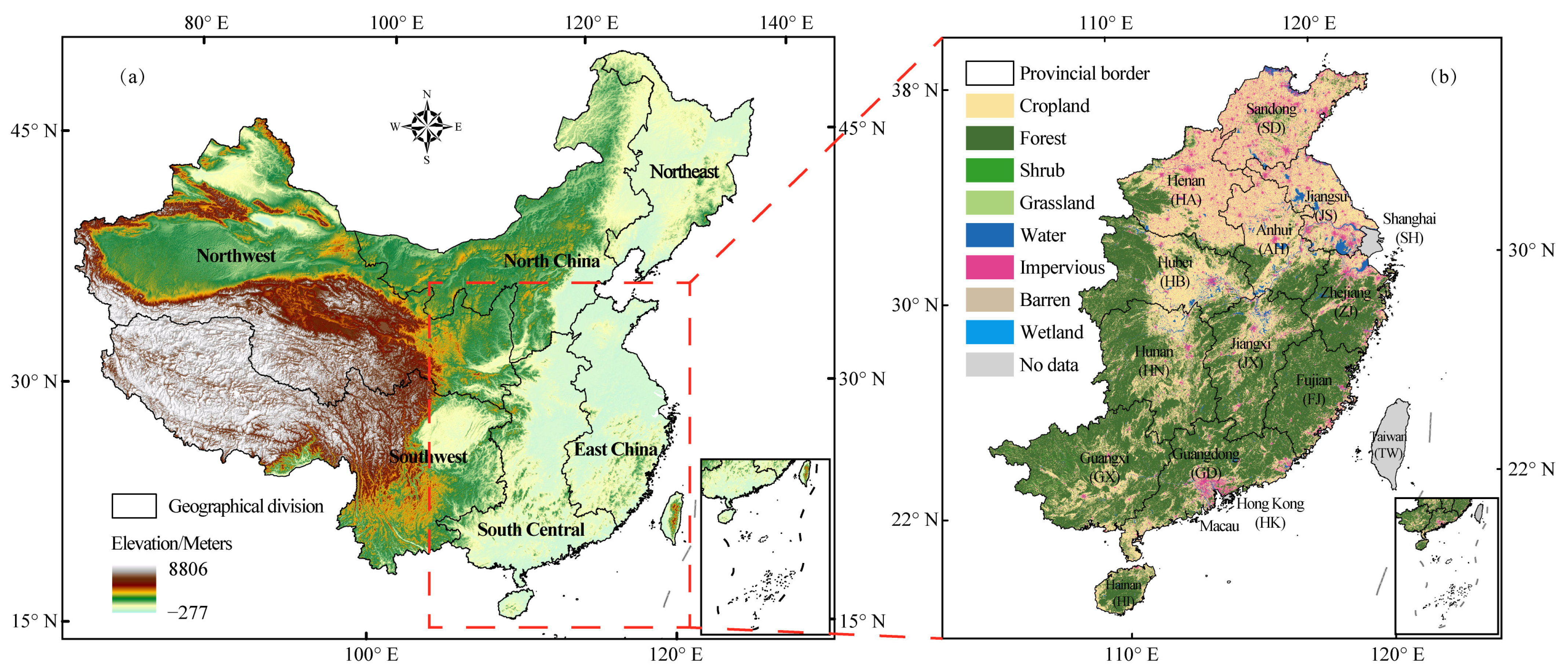

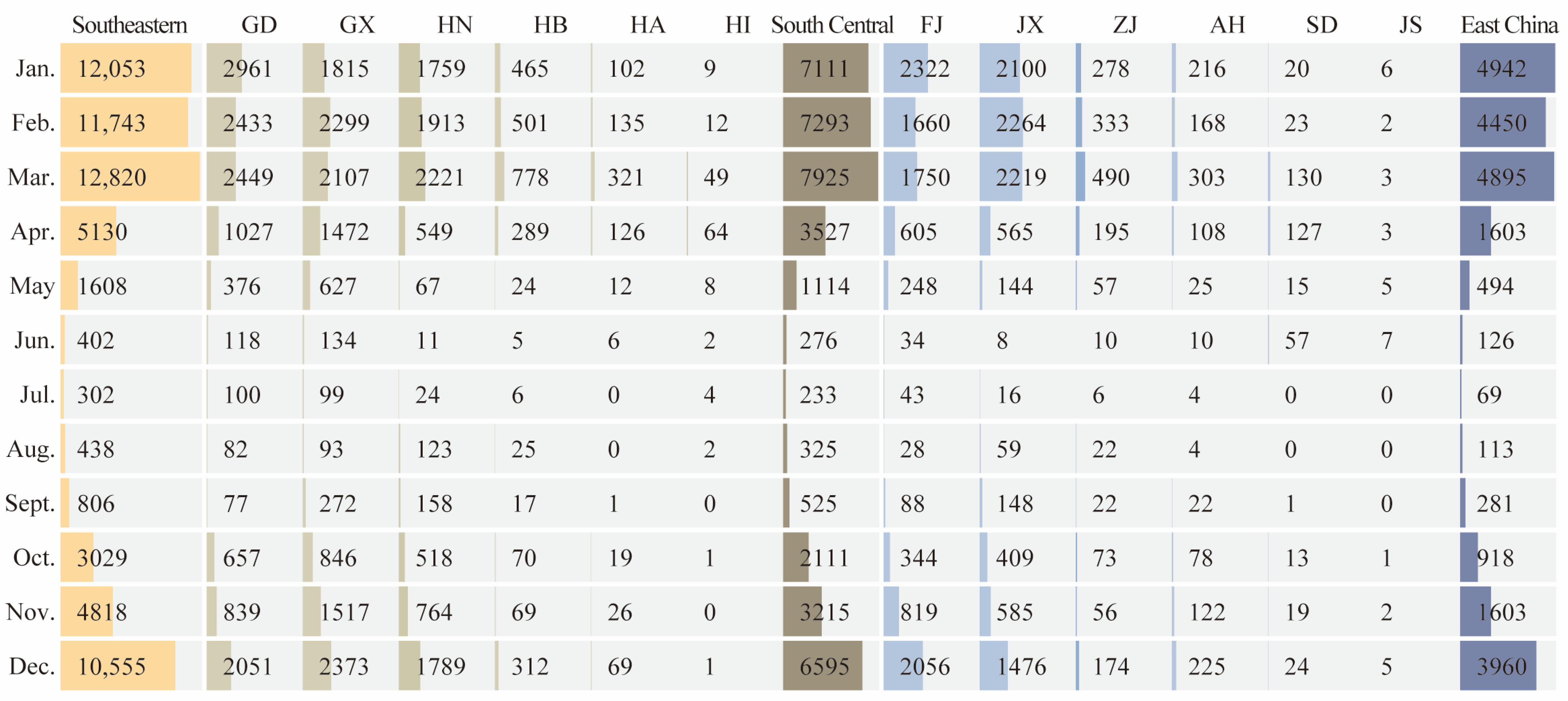
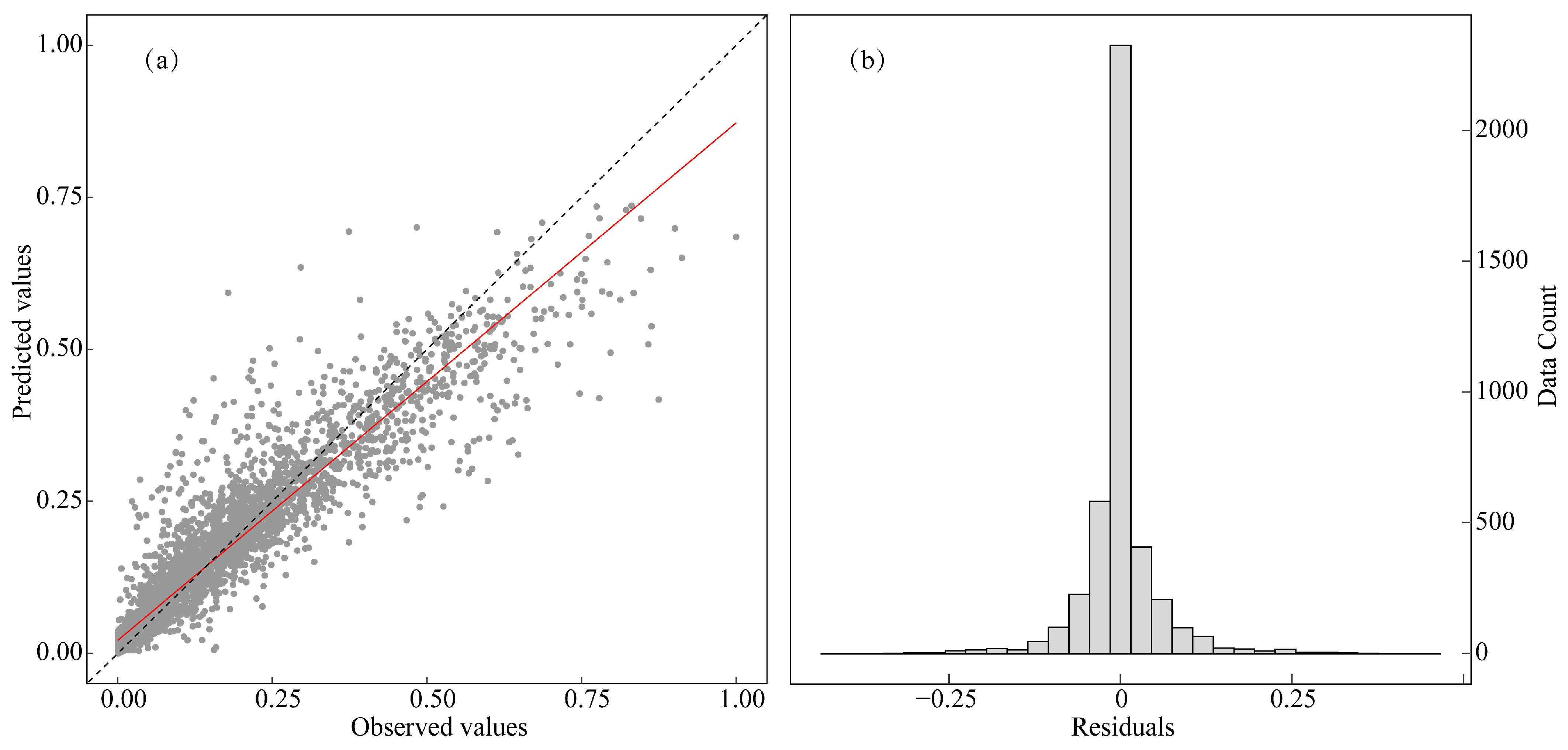
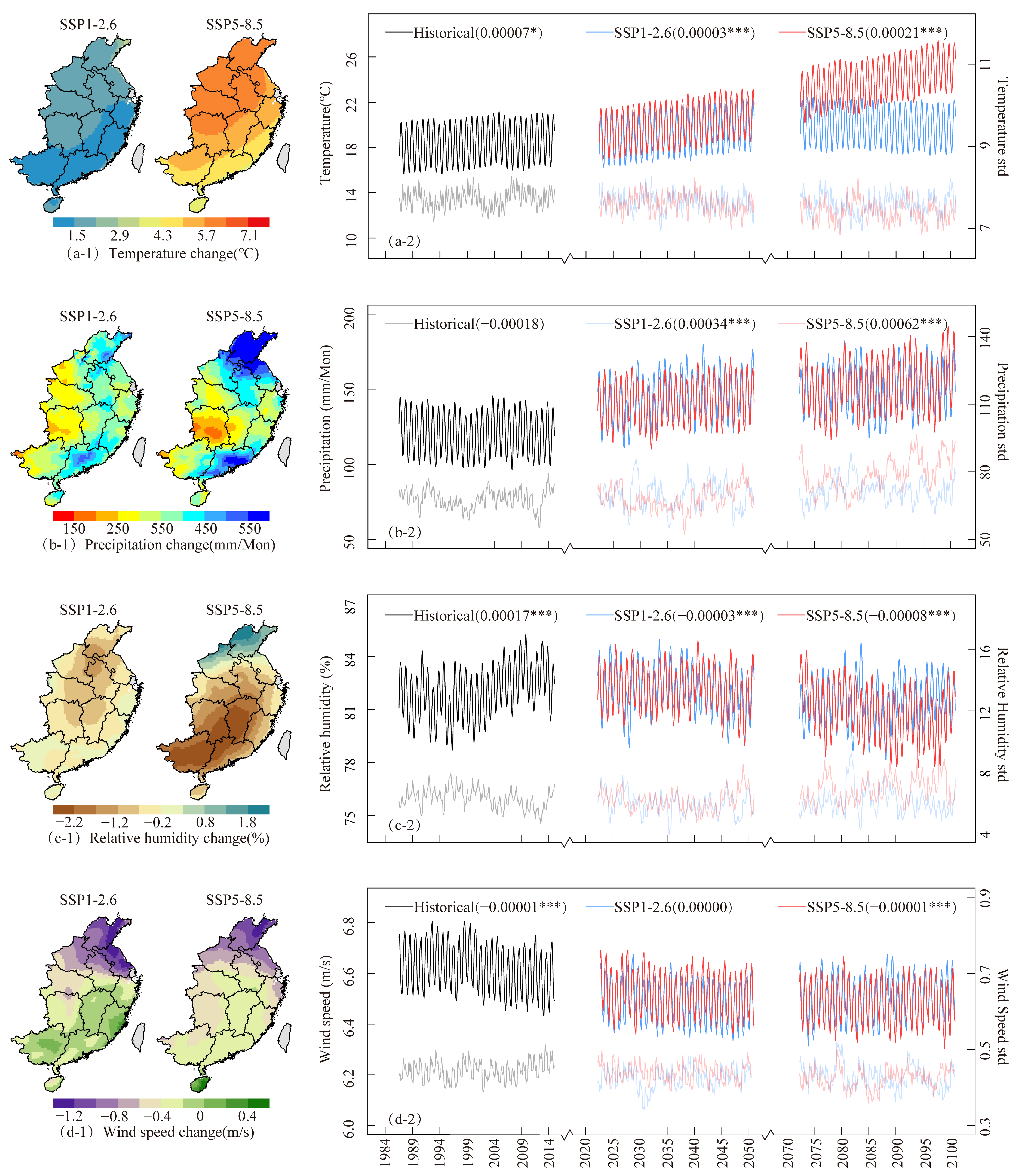
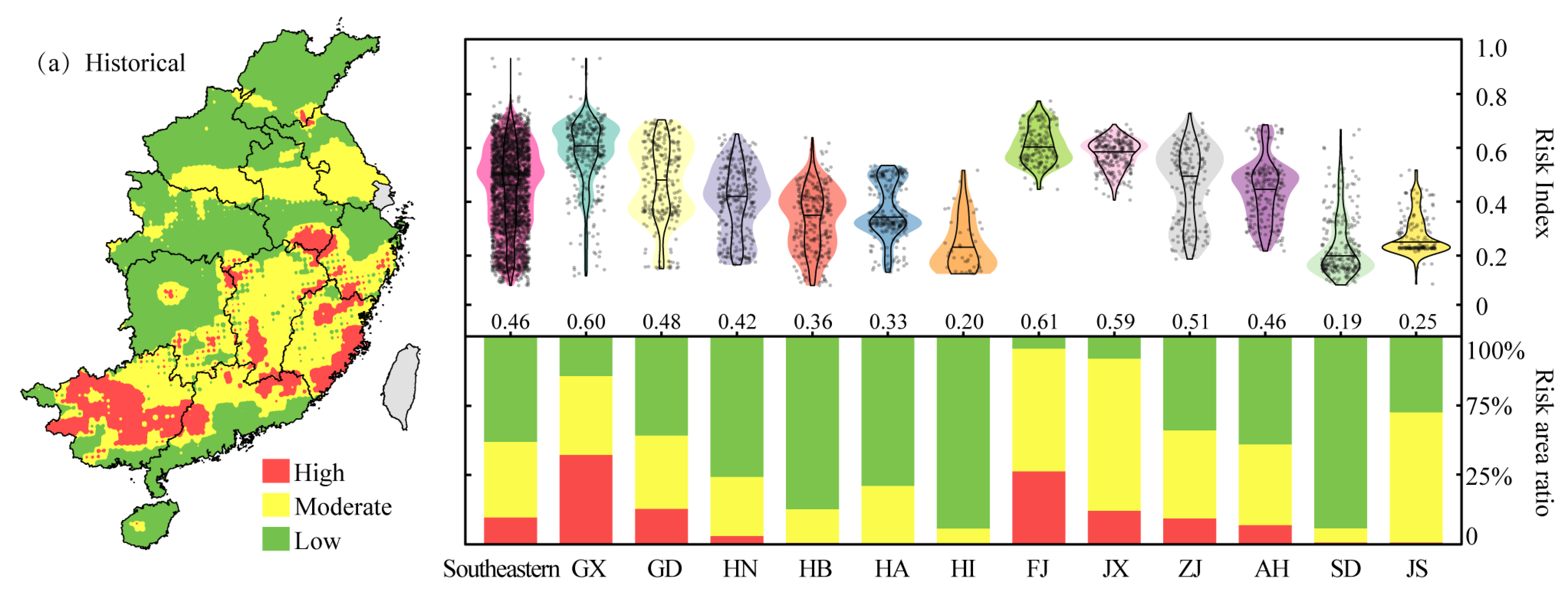
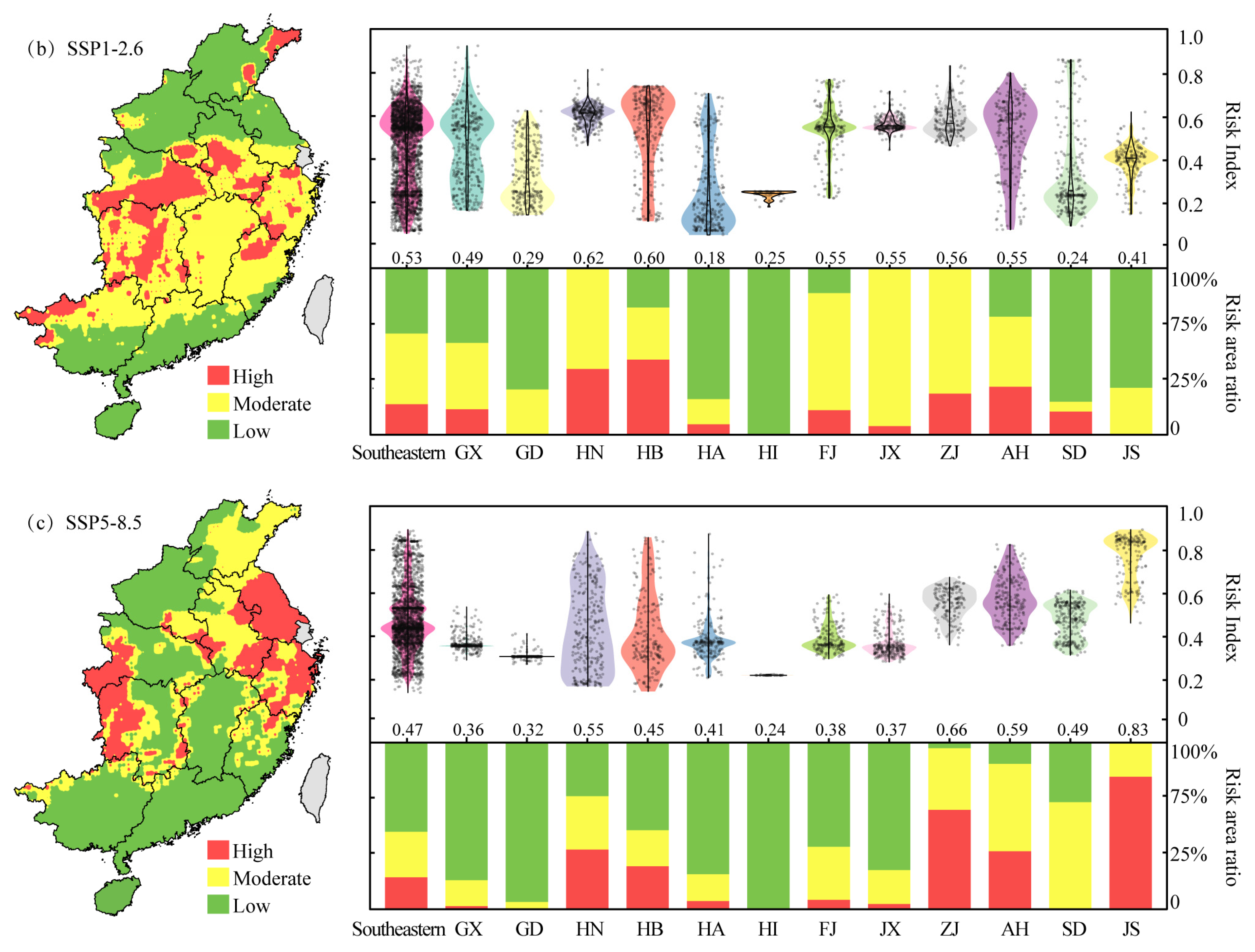
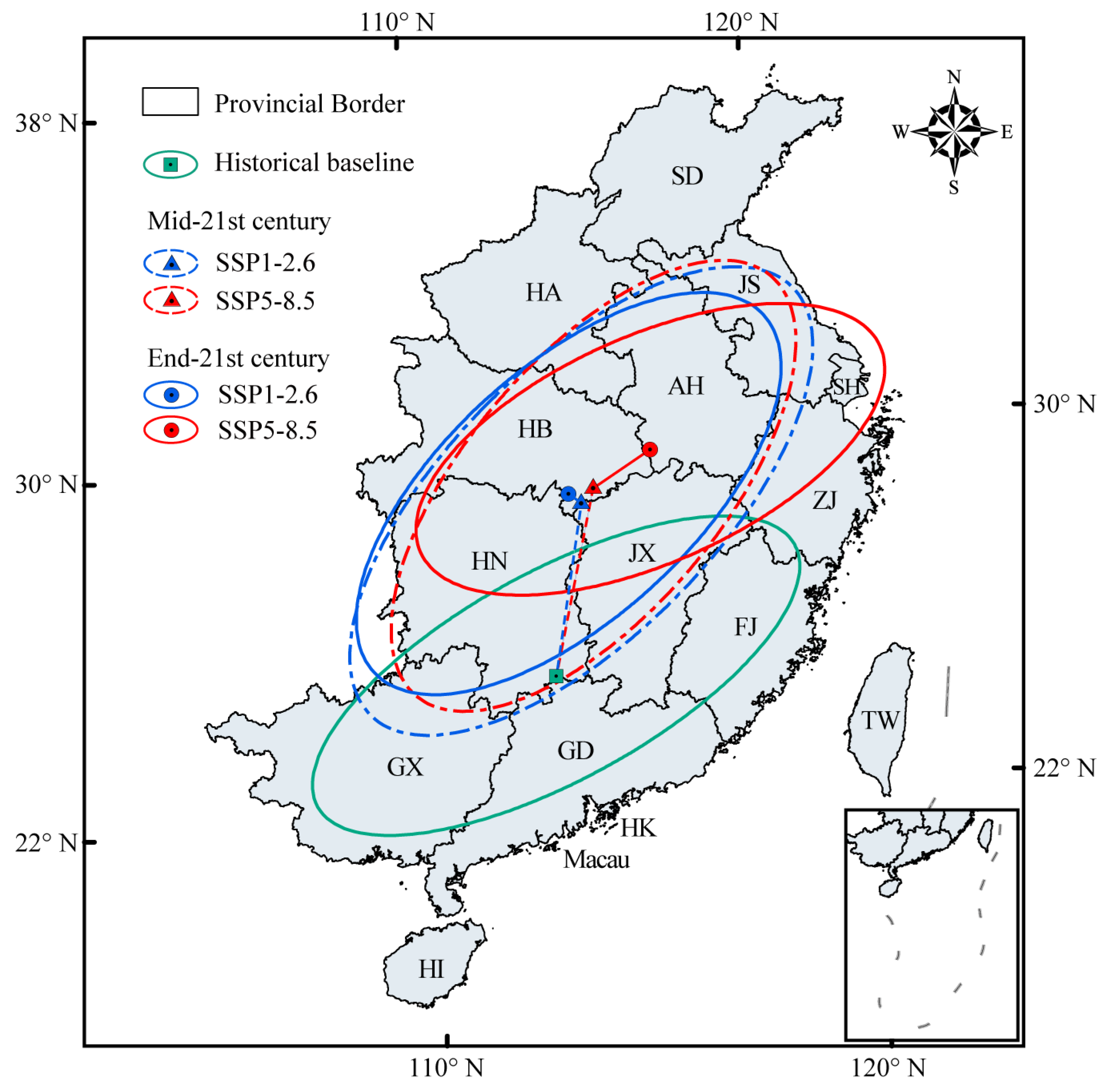
| Model | RMSE | MAE | R2 | CCC |
|---|---|---|---|---|
| Fold1 | 0.0556 | 0.0310 | 0.885 | 0.936 |
| Fold2 | 0.0557 | 0.0314 | 0.889 | 0.937 |
| Fold3 | 0.0577 | 0.0323 | 0.878 | 0.932 |
| Fold4 | 0.0553 | 0.0312 | 0.887 | 0.938 |
| Fold5 | 0.0577 | 0.0322 | 0.886 | 0.935 |
| Mean | 0.0564 | 0.0316 | 0.885 | 0.936 |
| Period | Scenario | Ellipse Area (104 km2) | Centroid X (km) | Centroid Y (km) | Major Axis (km) | Minor Axis (km) |
|---|---|---|---|---|---|---|
| Historical (1985–2014) | Historical baseline | 55.06 | 817.71 | 2704.25 | 677.09 | 258.90 |
| Mid-21st century (2021–2050) | SSP1-2.6 | 79.02 | 880.26 | 3139.76 | 748.04 | 336.31 |
| SSP5-8.5 | 68.26 | 910.69 | 3177.49 | 684.42 | 317.48 | |
| End-21st century (2071–2100) | SSP1-2.6 | 64.47 | 848.97 | 3158.22 | 658.01 | 311.88 |
| SSP5-8.5 | 55.42 | 1052.02 | 3268.47 | 626.80 | 281.47 |
Disclaimer/Publisher’s Note: The statements, opinions and data contained in all publications are solely those of the individual author(s) and contributor(s) and not of MDPI and/or the editor(s). MDPI and/or the editor(s) disclaim responsibility for any injury to people or property resulting from any ideas, methods, instructions or products referred to in the content. |
© 2025 by the authors. Licensee MDPI, Basel, Switzerland. This article is an open access article distributed under the terms and conditions of the Creative Commons Attribution (CC BY) license (https://creativecommons.org/licenses/by/4.0/).
Share and Cite
Gong, D.; Jing, M. Spatiotemporal Dynamics of Forest Fire Risk in Southeastern China Under Climate Change: Hydrothermal Drivers and Future Projections. Atmosphere 2025, 16, 1189. https://doi.org/10.3390/atmos16101189
Gong D, Jing M. Spatiotemporal Dynamics of Forest Fire Risk in Southeastern China Under Climate Change: Hydrothermal Drivers and Future Projections. Atmosphere. 2025; 16(10):1189. https://doi.org/10.3390/atmos16101189
Chicago/Turabian StyleGong, Dapeng, and Min Jing. 2025. "Spatiotemporal Dynamics of Forest Fire Risk in Southeastern China Under Climate Change: Hydrothermal Drivers and Future Projections" Atmosphere 16, no. 10: 1189. https://doi.org/10.3390/atmos16101189
APA StyleGong, D., & Jing, M. (2025). Spatiotemporal Dynamics of Forest Fire Risk in Southeastern China Under Climate Change: Hydrothermal Drivers and Future Projections. Atmosphere, 16(10), 1189. https://doi.org/10.3390/atmos16101189






